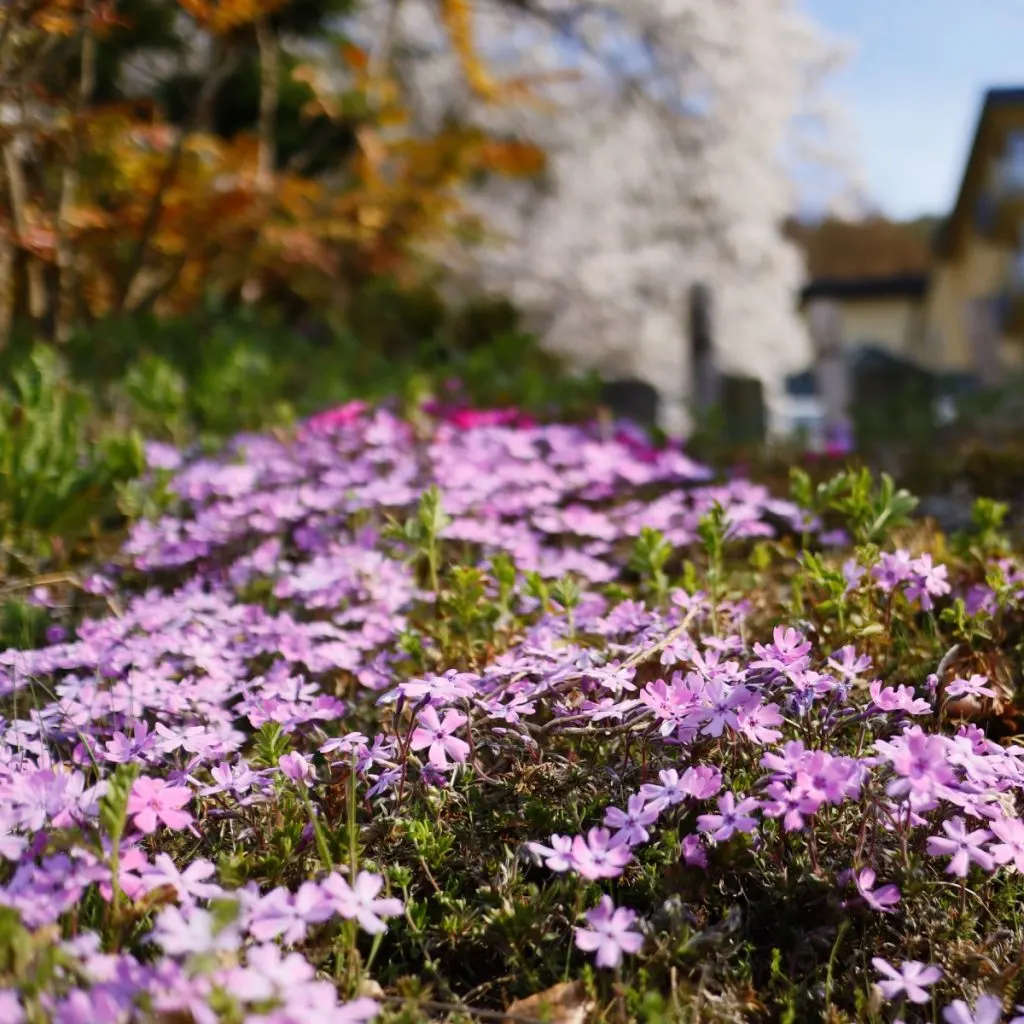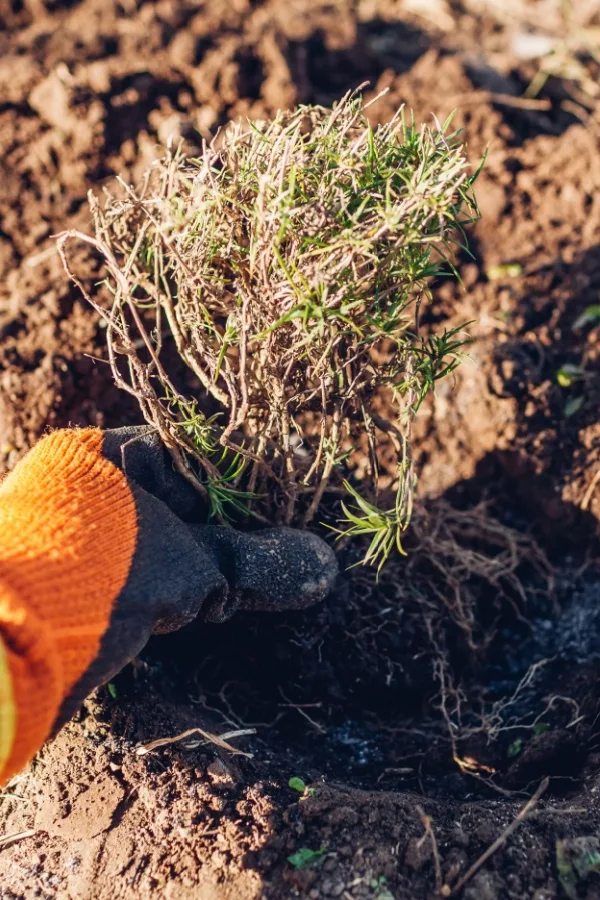Wondering what to do with your creeping phlox plants in the fall – and how to help prepare them for an amazing blooming season next year?
Phlox is one of the easiest, low-maintenance perennial plants to grow in your landscape. One of the best things about this hardy plant is that it isn’t picky at all about the soil it grows in. In fact, as long as it drains well, it can grow in almost any type of soil condition. As long, of course, as it gets plenty of sunshine!
In addition, phlox is fairly drought-tolerant, requiring only an inch of water each week to produce the stunning tiny blooms it is known for. But when it comes to keeping phlox at its best, it’s the care it receives in the fall that makes a huge difference in how the plants will perform the following spring and summer.

How To Care For Creeping Phlox In The Fall – 3 Big Chores To Help Keep Your Phlox Thriving!
#1 Cutting Back Plants
There are two main types of perennial phlox. One is a tall border phlox and the other is a low-profile creeping phlox. Both types can benefit from being cut back. This not only helps keep the growing space tidy and neat, but also helps the plants stay far healthier.
It’s best to cut back border phlox in the fall due to the plants being very susceptible to powdery mildew. Powdery mildew thrives in the cooler, wet weather that comes along during the fall.
By cutting plants back late in the season, you can help keep powdery mildew at bay, or in most cases, stop it from occurring altogether. The key is to remove the trimmed plant material completely from the growing space once you cut the plant back.
You should not add any foliage that shows signs of mildew to your home compost pile. Doing so will only cause more issues when you go to use the compost in the future. Also, be sure to disinfect and clean any tools used when cutting plants back. Product Link: Benefect Botanical Decon 30 Disinfectant Cleaner

Cutting Back Creeping Phlox – What To Do With Creeping Phlox In The Fall
Creeping phlox isn’t as susceptible to powdery mildew, but it still benefits from being cut back. You can cut back creeping phlox as soon as it is completely done with blooming. This usually ends up being anywhere between the middle of summer to early fall.
Cut both types of phlox back to around 2 to 3 inches above the ground. While it might seem severe, phlox will naturally lose its foliage once winter arrives. And once spring rolls around, new growth will quickly grow and fill in.
#2 Watering & Mulching – What To Do With Creeping Phlox In The Fall
While creeping phlox is drought tolerant, it still requires about an inch of rainwater or hand watering weekly – even in the fall. A lack of water will not usually kill the plant, but it will affect future blooms.
Even though the plants are not flowering late in the season, they still need sufficient water in order to stay healthy and thrive. Even more, proper watering in the fall allows them to store the energy they need to bloom bigger next year.
Watering is a simple task that often gets overlooked once the harsh heat of summer fades and the cooler weather arrives. Especially since they are no longer blooming. But if you are experiencing little to no rain, hand watering really is important.
When watering, do so early in the morning. This will help to allow the excess moisture to evaporate off of the plant’s foliage before nightfall. Watering at night combined with the cooler weather can increase the likelihood of powdery mildew.
Adding a few inches of organic mulch can help to retain moisture as well as protect the plant’s roots as well. Using mulch will also help to keep weeds at bay. Any weeds growing compete for nutrients as well as moisture. A good layer of mulch will help prevent this from happening.

#3 Dividing Overgrown Plants – Creeping Phlox In The Fall
As creeping phlox grows, it will naturally fill in all around your flowerbeds. But after growing for a few years, the plant can become very woody and thick. This usually happens about every 3 to five years – which is exactly when you should be dividing your plants.
Dividing plants can be very beneficial when you notice creeping phlox starting to slow down on bloom production. Dividing gives new life to cramped roots and plants. Even better, it’s a great way to get new perennial plants for free!
Fall is the best time of all to divide phlox. Doing so at this time gives newly planted phlox enough time to establish in the cooler weather and start new roots before winter arrives.
To divide, begin by cutting the plants back low to the ground. Next, carefully use a shovel to dig a few inches away from the perimeter of the plant. Dig down a few inches in the soil until you can lift the plant out of the ground. Phlox does not have particularly deep roots, so digging them out is usually an easy task.

All you need to do now is turn the plant over and split the roots into even sections. The easiest way to do this is to use a garden knife or small shovel. When replanting, get the divisions in the ground as soon as possible to help them set roots quickly. See: How To Divide & Transplant Perennials In The Fall
Avoid Fertilizing – What To Do With Creeping Phlox In The Fall
One thing you don’t want to do with your creeping phlox in the fall is to fertilize. Doing so late in the season will encourage the plant to produce new growth. Any new growth is then susceptible to freezing out when winter arrives.
Not only will this damage the tender new foliage, but it can end up being fatal to the entire plant as well. Instead, wait to fertilize phlox in early spring. Use a balanced fertilizer so the plant has enough energy to not only regrow back its foliage but also start to push out those tiny blooms.
Here’s to properly taking care of your creeping phlox this fall so that you can enjoy stunning blooms and healthy plants next year! For more on fall plant care, see What To Do With Rhododendrons In The Fall – And What Not To Before Winter Arrives!
This Is My Garden
Follow Our Facebook Page For Great Gardening Tips And Advice! This Is My Garden Facebook Page
This Is My Garden is a garden website created by gardeners, for gardeners. Jim and Mary Competti have been writing gardening, DIY and recipe articles and books and speaking for over 15 years from their 46 acre Ohio farm. They publish three articles every week, 52 weeks a year. Sign up today to follow via email, or follow along!
